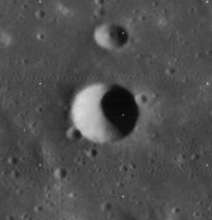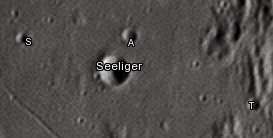Seeliger (crater)
 Lunar Orbiter 4 image | |
| Coordinates | 2°12′S 3°00′E / 2.2°S 3.0°ECoordinates: 2°12′S 3°00′E / 2.2°S 3.0°E |
|---|---|
| Diameter | 9 km |
| Depth | 1.8 km |
| Colongitude | 357° at sunrise |
| Eponym | Hugo H. R. von Seeliger |

Seeliger is a relatively small lunar impact crater that lies near the southeastern edge of Sinus Medii and is named after the German astronomner Hugo Hans Ritter von Seeliger. This is a circular, cup-shaped feature that has not been appreciably worn by impact erosion. Nearby prominent craters which are larger than Seeliger include Rhaeticus to the northeast, Hipparchus to the south and Réaumur (about 45 km) and Oppolzer (under 90 km) to the west.
From that location, the Earth appears at the zenith.
To the southeast is a rille named the Rima Réaumur, following a line to the northwest. In the north is the 110-km-long Rima Oppolzer, which divides the mare where Seeliger is situated from the remainder of the Sinus Medii.
Less than a crater diameter north is its satellite crater Seeliger A.
Satellite craters

By convention these features are identified on lunar maps by placing the letter on the side of the crater midpoint that is closest to Seeliger. Other than Seeliger A, Selliger S is to the west and Selliger T is further east-southeast.
| Seeliger | Latitude | Longitude | Diameter |
|---|---|---|---|
| A | 1.8° S | 3.0° E | 4 km |
| S | 2.1° S | 2.1° E | 4 km |
| T | 2.2° S | 4.4° E | 4 km |
References
- Andersson, L. E.; Whitaker, E. A. (1982). NASA Catalogue of Lunar Nomenclature. NASA RP-1097.
- Blue, Jennifer (July 25, 2007). "Gazetteer of Planetary Nomenclature". USGS. Retrieved 2007-08-05.
- Bussey, B.; Spudis, P. (2004). The Clementine Atlas of the Moon. New York: Cambridge University Press. ISBN 978-0-521-81528-4.
- Cocks, Elijah E.; Cocks, Josiah C. (1995). Who's Who on the Moon: A Biographical Dictionary of Lunar Nomenclature. Tudor Publishers. ISBN 978-0-936389-27-1.
- McDowell, Jonathan (July 15, 2007). "Lunar Nomenclature". Jonathan's Space Report. Retrieved 2007-10-24.
- Menzel, D. H.; Minnaert, M.; Levin, B.; Dollfus, A.; Bell, B. (1971). "Report on Lunar Nomenclature by the Working Group of Commission 17 of the IAU". Space Science Reviews. 12 (2): 136–186. Bibcode:1971SSRv...12..136M. doi:10.1007/BF00171763.
- Moore, Patrick (2001). On the Moon. Sterling Publishing Co. ISBN 978-0-304-35469-6.
- Price, Fred W. (1988). The Moon Observer's Handbook. Cambridge University Press. ISBN 978-0-521-33500-3.
- Rükl, Antonín (1990). Atlas of the Moon. Kalmbach Books. ISBN 978-0-913135-17-4.
- Webb, Rev. T. W. (1962). Celestial Objects for Common Telescopes (6th revised ed.). Dover. ISBN 978-0-486-20917-3.
- Whitaker, Ewen A. (1999). Mapping and Naming the Moon. Cambridge University Press. ISBN 978-0-521-62248-6.
- Wlasuk, Peter T. (2000). Observing the Moon. Springer. ISBN 978-1-85233-193-1.
External links
| Wikimedia Commons has media related to Seeliger (crater). |